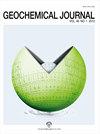日本纪井半岛温泉中的复合示踪剂:对日本西南弧前变质流体起源的启示
IF 1.6
4区 地球科学
Q3 GEOCHEMISTRY & GEOPHYSICS
引用次数: 2
摘要
日本地球化学学会版权所有©2021。slab-derived液体。然而,泉水的非大气δD-δ18O特征并不总是与火山样的He同位素特征相耦合。根据整个Kii半岛的观测,非大气δDδ18O特征主要分布在中构造线(MTL)的西侧,尽管地下水分布广泛,且3He/4He比值较高(Umeda et al., 2006;Morikawa et al., 2016)。泉水的空间变化可归因于原始深层流体的成分变化(Iwamori et al., 2020)。此外,非陨星δD-δ18O特征也可以通过粘土矿物脱水产生(Dählman and Lange, 2003)。由于粘土矿物脱水水的δD-δ18O特征与岩浆水的同位素范围重叠,因此不能用于区分其成因。本文采用Cl-B-Li分类学和混合模型对分布在日本纪井半岛的16个温泉的水源进行了区分。Li和B是轻元素,具有高迁移率的特点,与Cl相似,但不相容程度不同,取决于伴生矿物相和温度。因此,这些元素的比例已被用于了解成岩和变质过程(Trompetter等人,1999;marshall et al., 2009;Reyes and Trompetter, 2012)。Reyes和Trompetter(2012)在日本Kii半岛的温泉中发现了不同的cl - b组合示踪剂:对日本西南弧前变质流体起源的影响本文章由计算机程序翻译,如有差异,请以英文原文为准。
Combined tracers in hot spring waters across the Kii Peninsula, Japan: Implications for the origins of metamorphic fluids of the SW Japan forearc
Copyright © 2021 by The Geochemical Society of Japan. slab-derived fluid. However, non-meteoric δD-δ18O signatures in spring waters are not always coupled with volcanic-like He isotopic signatures. According to observations from across the Kii Peninsula, non-meteoric δDδ18O signatures are specifically distributed on the western side of the median tectonic line (MTL), despite the wide distribution of groundwater with high 3He/4He ratios (Umeda et al., 2006; Morikawa et al., 2016). Spatial variations of spring waters may be attributed to compositional variations of the original deep fluid (Iwamori et al., 2020). Moreover, non-meteoric δD-δ18O signatures can also be produced by clay mineral dehydration (Dählman and Lange, 2003). Because the δD-δ18O signatures of dehydrated water from clay minerals overlap the isotopic range of magmatic water, the signature could not be used for distinguishing the origins. In this study, we used Cl-B-Li systematics and a mixing model to distinguish the origins of the water from 16 hot springs distributed across the Kii Peninsula, Japan. Li and B are light elements that are characterized by high mobility and are similar to Cl, but with different degrees of incompatibility, depending on the associated mineral phases and temperatures. Therefore, the proportion of these elements has been used for understanding diagenetic and metamorphic processes (Trompetter et al., 1999; Marschall et al., 2009; Reyes and Trompetter, 2012). Reyes and Trompetter (2012) showed the different Cl-BCombined tracers in hot spring waters across the Kii Peninsula, Japan: Implications for the origins of metamorphic fluids of the SW Japan forearc
求助全文
通过发布文献求助,成功后即可免费获取论文全文。
去求助
来源期刊

Geochemical Journal
地学-地球化学与地球物理
CiteScore
1.70
自引率
12.50%
发文量
11
审稿时长
6 months
期刊介绍:
Geochemical Journal is an international journal devoted to original research papers in geochemistry and cosmochemistry. It is the primary journal of the Geochemical Society of Japan. Areas of research are as follows:
Cosmochemistry; Mineral and Rock Chemistry; Volcanology and Hydrothermal Chemistry; Isotope Geochemistry and Geochronology; Atmospheric Chemistry; Hydro- and Marine Chemistry; Organic Geochemistry; Environmental Chemistry.
 求助内容:
求助内容: 应助结果提醒方式:
应助结果提醒方式:


